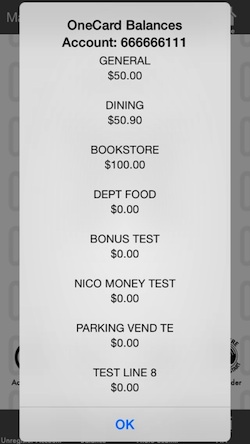Heartland Goes Mobile with ID Card
- By Dian Schaffhauser
- 04/30/14

Heartland Payment System's OneCard Mobile can be used as identification, for payment, to manage accounts and more. |
Considering that students rarely let go of their smartphones, it makes sense that a major campus ID card vendor would launch a mobile app that eliminates the need for the card itself. Heartland Payment Systems has introduced OneCard Mobile, with Apple iOS and Android app versions that combine and add functionality to the company's other mobile programs. Those include MyPay for financial transactions, MyAccess for door security, and MyAccount for account management.
"Students today are inseparable from their smartphones, so we decided to rethink the entire campus mobile technology model," said Melissa Peirano, OneCard general manager.
The app, which has been tested at Mount Holyoke College among other colleges and universities, uses geo-fencing and QR codes to enable activities. As a student approaches a door that's locked, for example, the app detects his or her access rights and pops up a dialog on the device that asks if access is needed. The student can slide a tiny virtual image of the ID card to unlock the door. Or the campus can place a QR code on the door, which the mobile app can scan to allow for entry. The app also shows which doors in the vicinity can be opened by the student at that time.
When a student uses the app to make a purchase, as he or she approaches the point of sale terminal, the cashier can ring up the order, specify a OneCard Mobile transaction, and the student's name and photo will display on the POS screen to allow the transaction to be finalized. "The student almost doesn't need to stop," said Fred Emery, vice president of sales for Heartland's Campus Solutions division. "They slow down by the cashier and then can continue on." Since the cashier can see the student's personal information on the display, he or she can call the student by name, which, noted Emery, creates a "better user experience" and makes the student feel like part of a community.
Vending machines, copiers and laundry machines can use the QR code approach to give the student the ability to make a purchase. The app also gives the user access to his or her OneCard account for managing finances such as checking balances and depositing funds.
The app also takes advantage of smartphone picture capabilities. Instead of waiting in line for an official ID photo to be taken for inclusion on the virtual student ID card, the student can take a selfie, the university can approve it, and that will appear on the app's card.
Security on the app takes several forms. One level is provided by the mobile device's passcode. User access can also be integrated with the campus' network authentication; when a user loses campus credentials, he or she will also lose access control. And the school can impose additional security with passwords and PIN codes for certain types of transactions. The application behind the app also allows students to be logged into only a single device at a time.
On the administrative side, the app can be branded with campus colors and the institution's logo. The technology works alongside existing OneCard terminals; those customers with the app can use that form of campus card and those without it can use the traditional ID card.
Although OneCard Mobile can be added to an existing campus mobile app as an additional icon, Heartland is also hoping to woo campuses that don't already have a mobile app by offering similar features, including maps, dining options, events, library and other student services and social media. According to Emery, the app can be configured and new functionality added as long as there is a URL involved.
Pricing for the use of the mobile app at a school is modular. Campuses with the OneCard system in place purchase the modules they need. If an institution only wants the financial functions, for example, and not access control or other campus features, the price will be scaled "accordingly," Emery said.
Set-up involves implementing a Web service developed by Heartland and then going to each terminal or other location where the ID card can be used, specifying that it is OneCard-enabled and setting its geo-location. After that, said Emery, it's a matter of "marketing to students to download the app, choose their campus from within the app and register their card account."
Emery anticipated that the new app could generate increased revenue for campuses that adopt it. "When campus cards were initially implemented, the industry saw a huge increase in convenience purchases because you were using the card and not having to pull out cash. With the mobile app you'll see even more of an increase in those convenience or impulse purchases because you can do it from a mobile phone that's in your hands."
But ultimately, he added, the new app will allow the campus to provide an experience "of convenience" to students "beyond transactions."
A video showing the use of OneCard Mobile at Mt. Holyoke has been posted to YouTube.
About the Author
Dian Schaffhauser is a former senior contributing editor for 1105 Media's education publications THE Journal, Campus Technology and Spaces4Learning.